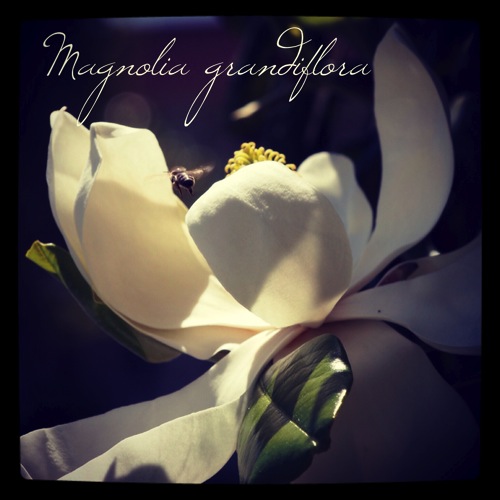Magnolia Grandiflora
These large trees, with heavy, waxy leaves and large, blowzy flowers are quite common here in Los Angeles. They put on quite a show each year and seem to grep quite reliably and trouble free. As you might see in the photo, the bees like them, too.
Follow DouglasWelch in Instagram
Magnolia grandiflora, commonly known as the southern magnolia or bull bay, is a tree of the family Magnoliaceae native to the southeastern United States, from Virginia south to centralFlorida, and west to eastern Texas and Oklahoma. Reaching 27.5 m (90 ft) in height, it is a large striking evergreen tree with large dark green leaves up to 20 cm (8 in) long and 12 cm (4.5 in) wide and large white fragrant flowers up to 30 cm (12 in) in diameter. Widely cultivated around the world, over a hundred cultivars have been bred and marketed commercially. The timber is hard and heavy, and has been used commercially to make furniture, pallets, and veneer.
Magnolia grandiflora is a medium to large evergreen tree which may grow 90 ft (27.5 m) tall.[1] It typically has a single stem (or trunk) and a pyramidalshape.[2] The leaves are simple and broadly ovate, 12–20 cm (5–8 in) long and 6–12 cm (2–5 in) broad,[2] with smooth margins. They are dark green, stiff and leathery, and often scurfy underneath with yellow-brown pubescence. The large, showy, lemon citronella-scented flowers are white, up to 30 cm (12 in) across and fragrant, with 6–12 petals with a waxy texture, emerging from the tips of twigs on mature trees in late spring. Flowering is followed by the rose-coloured fruit, ovoid and 7.5–10 cm (3–4 in) long and 3–5 cm (1.5–2 in) wide.[3]
Exceptionally large trees recorded include a 35 m (114 ft) high specimen from the Chickasawhay District, De Soto National Forest in Mississippi which measured 17 feet 8 inches in circumference at breast height, from 1961, and a 30 m (99 ft) tall tree from Baton Rouge in Louisiana which reached 18 feet in circumference at breast height.[3] — Wikipedia
More information on Magnolia grandiflora:
- Magnolia Grandiflora – In the neighborhood on A Gardener’s Notebook
- Magnolia grandiflora on Wikipedia
- Magnolia grandiflora at University of Connecticut
- Magnolia grandiflora at the Missouri Botanical Garden
- Acanthus
- Amaryllis
- Apricot (Prunus armeniaca)
- Aspen
- Azalea
- Banana
- Bonsai
- Bougainvillea
- Brugmansia
- Butterfly (Lepidoptera)
- California Flannelbush (Fremontodendron californicum)
- California Poppy (Eschscholzia californica)
- Calla Lily (Zantedeschia aethiopica)
- Campsis radicans
- Castor Bean (Ricinus)
- Caltapa
- Chives (Allium schoenoprasum)
- Clematis
- Camellia
- Currant (Ribes)
- Dahlia
- Datura
- Japanese Cherry (Prunus serrulata)
- Daffodil (Narcissus)
- Dietes (Fortnight Lily)
- Dudleya
- Echinacea
- Ecualyptus
- Freesia
- Fungi
- Gerbera Daisy
- Grape (Vitis vinifera)
- Helianthus (sunflower)
- Hibiscus (Malvaceae)
- Iris
- Jacaranda mimosifolia
- Joshua Tree (Yucca brevifolia)
- Kniphofia “Red Hot Poker”
- Lantana
- Lavender (Lavendula)
- Kousa Dogwood (Cornus kousa)
- Magnolia x soulangeana (Saucer Magnolia/Tulip Tree)
- Mandevilla
- Marigold (Calendula officinalis)
- Matilija Poppy (Romneya)
- Morning Glory (Convolvulaceae)
- Nandina
- Oleander (Nerium)
- Orange
- Orchid from the Southern California Spring Garden Show 2013
- Oriental Poppy (Papaver orientale)
- Polygonatum (Solomon’s Seal)
- Paperwhites
- Pineapple (Ananas comosus)
- Primula (Primrose)
- Queen Anne’s Lace (Daucus carota)
- Rosa ‘Mikado’
- Rudbeckia
- Salvia
- Squirrel
- Star Jasmine (Trachelospermum jasminoides)
- Succulents
- California Sycamore (Platanus racemosa)
- Sweet Potato (Ipomoea batatas)
- Tomato
- Water Lily (Nymphaeaceae)
- Wisteria






